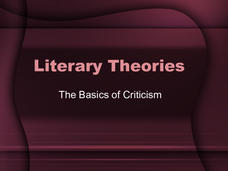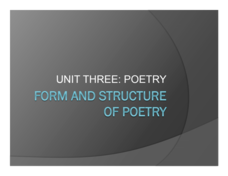Curated OER
Literary Analysis: Summary vs. Analysis
What is the difference between summary writing and literary analysis? A 16-slide presentation offers some basic requirements for both types of writing and helps readers identify each based on keywords used in both types of writing....
Curated OER
Writing a Literary Analysis
What makes writing literary? What comprises analysis? A 15-slide PowerPoint presentation, created by the Purdue University Writing Lab, tackles these questions. The explanations of what makes writing literary and what comprises analysis...
Livaudais-Baker English Classroom
Literary Theories
Introduce ELA scholars to the basics of literary criticism with a 41-slide presentation that identifies eight different approaches to critical analysis. Each approach is defined, and advantages and disadvantages are listed. Also included...
Curated OER
How to Write the Thesis Statement
A thesis statement is one of the most important aspects in a paper; make sure your class can create solid, concise statements for each of their large essays, particularly analytical essays. This presentation is extremely thorough, and it...
Curated OER
Grapes of Wrath: Setting up Historical Context
Discuss life in the 1930s in relation to the Dust Bowl and Great Depression, then do a cross-media analysis. Here you'll find background information on film maker John Ford, writer John Steinbeck, and 1930s America. You can compare the...
Curated OER
Metaphor and Metonymy
If you are teaching metaphors in your language arts class, consider using this presentation to illustrate several examples of classic metaphors. Body metaphors, war metaphors, and comic metaphors all help learners understand the...
E Reading Worksheets
Tone: Voice of the Speaker
Tone and mood are easy to use interchangeably—and yet they are very different elements of literature. Help middle schoolers discern between the way a speaker feels about his or her subject and the way the audience is meant to feel with a...
Curated OER
The Conclusion Paragraph
Strike a note of hope or despair. Give a symbolic detail. Use a meaningful quotation. These strategies and others are part of a presentation on the purposes of and how to craft a conclusion. Sample conclusions are included for the class...
Curated OER
Generating Topic Sentences
A great look at topic sentences is presented here. First, the function of a topic sentence is explained and common errors are listed. Then, you will walk your class through the five example topic sentences to discuss their quality.
Curated OER
Urban Legends
Irony, hyperbole, and other rhetorical devices are at play in this presentation about urban legends. Several examples of urban legends help to clarify the analysis, making it valuable for those who have a hard time wrapping their mind...
Springfield Public Schools District 186
Form and Structure of Poetry
If anyone suffers from metrophobia—the fear of poetry—the PowerPoint on the elements of poetry may help alleviate their worries. The presentation introduces learners to poetic elements, including simile, metaphor, and personification....
Curated OER
APA and MLA Formats: Their Main Differences
What is the difference between MLA and APA format? This presentation is geared towards a college audience, but it could definitely be useful with an eleventh and twelfth grade audience in high school. Differences are highlighted, but not...













